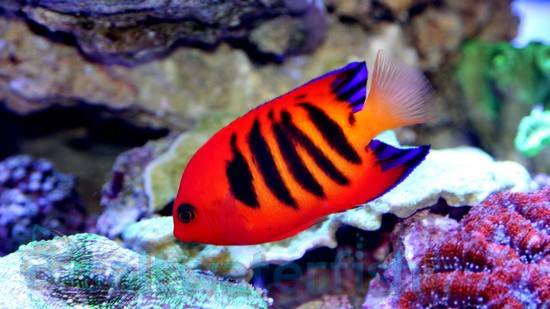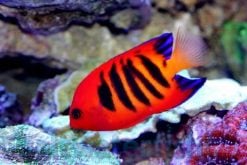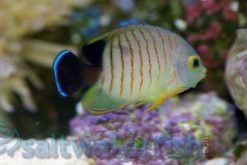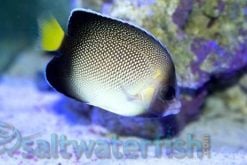Flame Angelfish – (Centropyge loriculus)
Quick Stats:
- Care Level: Moderate
- Temperament: Semi-aggressive
- Diet: Omnivore
- Reef Safe: With Caution
- Minimum Tank Size: 30 gallons
- Max Size: 4 inches
- Water Parameters: pH 8.1-8.4, Salinity 1.020-1.025
Comprehensive Guide to the Flame Angelfish – (Centropyge loriculus)
Habitat:
The Flame Angelfish is native to the waters of the Indo-Pacific region, specifically around the Philippines and Indonesia. They inhabit coral reefs, lagoons, and rocky areas with plenty of hiding spots.
Reef Safe:
The Flame Angelfish is generally not considered reef safe. While they may not harm corals directly, they have been known to nip at the polyps of some corals, particularly stony corals. It is recommended to observe their behavior closely and provide ample hiding spots.
Size:
The Flame Angelfish can reach a maximum size of around 4 inches in captivity.
Temperament:
Flame Angelfish have a semi-aggressive temperament. They can be territorial towards other angelfish and may show aggression towards smaller, more passive tankmates. It is important to provide plenty of hiding spots and space for them to establish their own territory.
Sexual Dimorphism:
There are no distinct external differences between male and female Flame Angelfish.
Lifespan:
With proper care, Flame Angelfish can live for up to 10 years in captivity.
Diet in Aquariums:
Flame Angelfish are omnivores and have a varied diet. They should be fed a combination of high-quality flakes, pellets, frozen foods (such as mysis shrimp and brine shrimp), and live foods (such as copepods and amphipods) to ensure a balanced diet.
Aquascaping Recommendations:
It is important to provide plenty of hiding spots and places for the Flame Angelfish to explore. Use live rock to create caves, crevices, and overhangs where they can feel secure. The addition of corals and other invertebrates can also provide additional hiding spots and enrich the overall aesthetics of the tank.
Captive Bred Availability:
The Flame Angelfish is available as captive bred, which is a great option for those who prefer to support sustainable aquarium practices. Captive bred specimens are generally hardier and more adaptable to aquarium conditions than their wild-caught counterparts.
Compatibility with Other Fish, Invertebrates, or Corals:
Flame Angelfish can be kept with other semi-aggressive or similarly sized fish species. However, caution should be exercised when adding them to a reef tank with corals as they may nip at the polyps of certain corals. It is important to research compatibility with specific corals before adding them to the tank.
Here are 5 specific tankmates that can be good choices:
- Gobies: Gobies are small, peaceful fish that can coexist well with Flame Angelfish.
- Damsels: Certain species of damsels can tolerate the semi-aggressive nature of Flame Angelfish.
- Wrasses: Some wrasses are compatible with Flame Angelfish and can add vibrant colors to the tank.
- Tangs: Tangs are generally larger and more robust, making them good companions for Flame Angelfish.
- Blennies: Blennies are active fish that can do well with Flame Angelfish in larger tanks.
Other Common Names:
The Flame Angelfish is also known as the Dwarf Flame Angelfish or Flame Angel.
Why Buy from Reefs4Less.com?
Reefs4Less.com is a reputable online retailer specializing in saltwater aquarium products. They offer a wide selection of high-quality fish, corals, and aquarium supplies at competitive prices. Their customer service is exceptional, ensuring a smooth and satisfactory shopping experience. Additionally, Reefs4Less.com prioritizes sustainable practices, including offering captive bred specimens whenever possible.
Popular Questions and Answers:
Q: Can Flame Angelfish be kept in a community tank?
A: Flame Angelfish can be kept in a community tank with caution. They may show aggression towards smaller or more passive tankmates, so it is important to choose compatible species and provide ample hiding spots.
Q: How often should I feed my Flame Angelfish?
A: It is recommended to feed Flame Angelfish small amounts multiple times a day. This mimics their natural feeding behavior and helps ensure they receive a balanced diet.
Q: Can Flame Angelfish be kept in a reef tank?
A: While Flame Angelfish may not harm corals directly, they have been known to nip at the polyps of certain corals. It is important to research compatibility with specific corals before adding them to a reef tank.
Q: Do Flame Angelfish require a specific lighting setup in the aquarium?
A: While Flame Angelfish do not have specific lighting requirements, providing moderate to high lighting can enhance the colors of their vibrant markings.
Q: What is the ideal temperature range for Flame Angelfish?
A: The ideal temperature range for Flame Angelfish is between 76-82F (24-28C).
| Size | < 2 inches |
|---|






Reviews
There are no reviews yet.